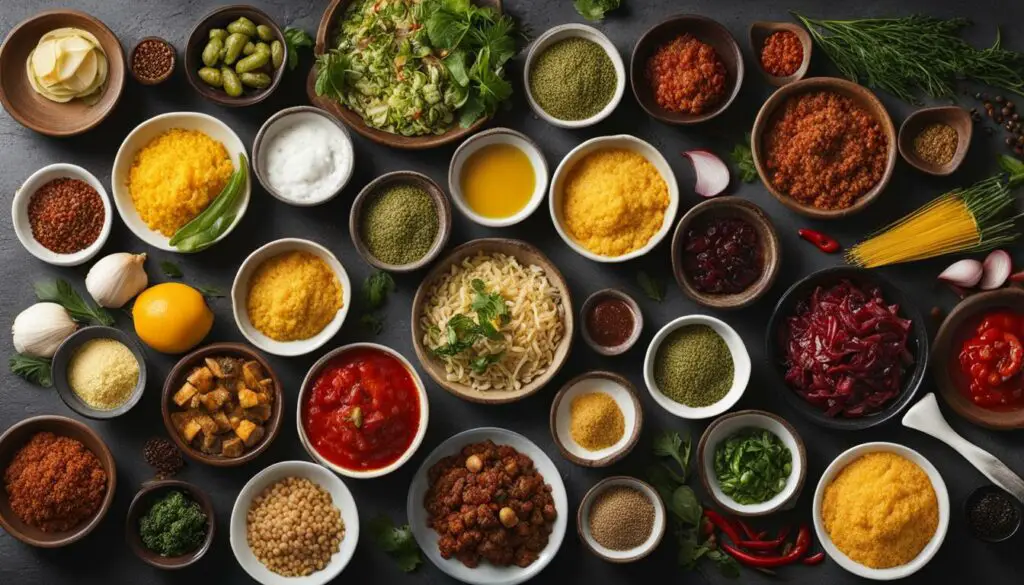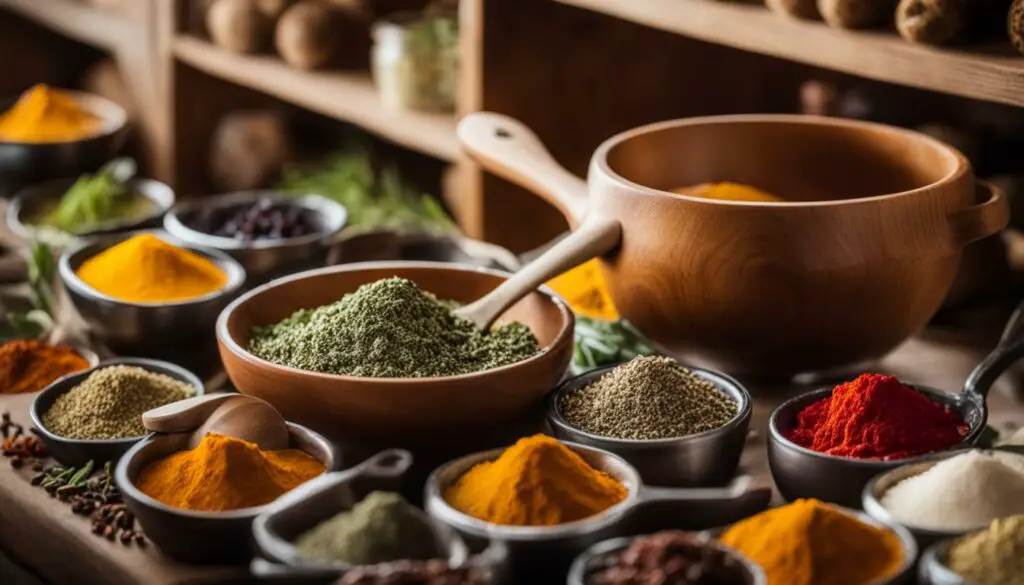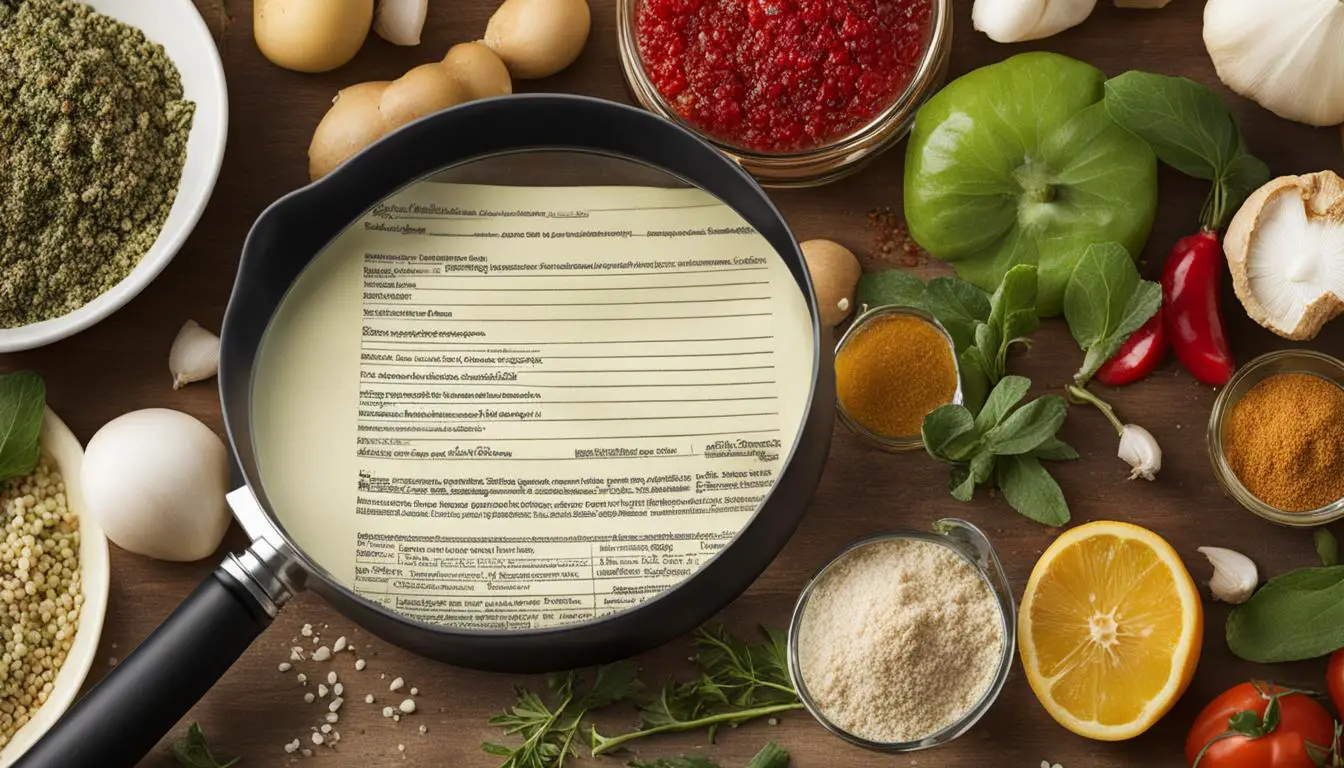Leaving a great review on a modified recipe may not accurately reflect the true experience of cooking and enjoying a dish. While it’s tempting to share positive feedback after making changes to a recipe, it’s important to provide honest feedback that reflects the modifications made and their impact on the dish. By following recipe review tips and guidelines, you can optimize your recipe reviews and enhance recipe feedback, contributing to a more authentic culinary community.
Contents
- 1 The Importance of Respecting Traditional Recipes
- 2 Understanding Recipe Modification
- 3 Avoiding Recipe Bastardization
- 4 Starting with the Original Recipe
- 5 Identifying Inflexible Elements in Recipes
- 6 Thoughtful Consideration for Recipe Modification
- 7 Avoiding Overdoing Recipe Modifications
- 8 Embracing Recipe Evolution
- 9 Copyright Considerations for Recipe Sharing
- 10 Conclusion
- 11 FAQ
- 11.1 Why is it not recommended to leave great reviews on modified recipes?
- 11.2 Why is it important to respect traditional recipes?
- 11.3 What is recipe modification?
- 11.4 How can recipes be diversified?
- 11.5 What is recipe bastardization?
- 11.6 What should be done before making modifications to a recipe?
- 11.7 Are there limitations to recipe modification?
- 11.8 How can recipes be thoughtfully modified?
- 11.9 How can overdoing recipe modifications be avoided?
- 11.10 How can recipes be continuously improved?
- 11.11 What are the copyright considerations for sharing recipes?
- 12 Source Links
Key Takeaways:
- Don’t leave a great review after changing a recipe – be honest about your experience.
- Follow recipe rating guidelines to optimize your recipe reviews.
- Enhance recipe feedback by providing detailed information about the modifications made.
- Give honest recipe reviews that reflect your true cooking and tasting experience.
- Take the opportunity to improve recipe feedback and contribute to the culinary community.
The Importance of Respecting Traditional Recipes
Traditional recipes hold cultural significance and represent a part of our culinary history. They have been passed down through generations, preserving unique flavors, techniques, and cultural heritage. Modifying recipes can be a creative process that allows for personalization and experimentation in the kitchen. However, it is crucial to approach recipe modification with respect for the original recipe and its cultural context.
Recipe diversification is acceptable and can be a way to meet different dietary needs or adapt to ingredient availability. It allows for the evolution of traditional recipes while still honoring their roots. For example, adjusting a traditional pasta recipe to accommodate gluten-free pasta or substituting local ingredients to maintain the authenticity of a regional dish while making it accessible to different audiences.
Traditional recipes are culinary treasures that reflect the cultural heritage and identity of a community. They symbolize the traditions, values, and stories of a particular region, and modifying them without thought can diminish their cultural significance and betray the culinary heritage.
On the other hand, recipe bastardization is a term used to describe excessively modifying a traditional recipe without acknowledging its origins. It involves making changes that disregard the fundamental elements of the dish, resulting in a version that deviates drastically from the original. Recipe bastardization not only erases the cultural context but also risks losing the essence and unique flavors that make the traditional dish special.
By respecting traditional recipes, we pay homage to the culinary traditions that have shaped our food culture. We preserve and celebrate the diverse flavors and techniques that have been passed down through generations. While modification and diversification are valuable processes in culinary exploration, they should be approached with care and thoughtfulness to ensure that the integrity and cultural heritage of traditional recipes remain intact.
The Role of Culinary Preservation
Culinary preservation plays a vital role in maintaining traditional recipes. It involves documenting, promoting, and safeguarding these recipes to ensure their longevity. By preserving traditional recipes, we contribute to the preservation of cultural identities and the rich tapestry of our culinary heritage. Culinary preservation allows us to pass on knowledge, skills, and flavors to future generations, ensuring that traditional recipes continue to be appreciated and celebrated.
| Benefits of Respecting Traditional Recipes | Consequences of Recipe Bastardization |
|---|---|
|
|

Respecting traditional recipes is not about rigid adherence to the past but about understanding their significance and making modifications with intention. By embracing traditional recipes and showcasing their unique flavors and techniques, we contribute to the culinary world while preserving the essence of cultural heritage. Let us embark on a culinary journey that honors tradition, celebrates diversity, and embraces the richness of traditional recipes.
Understanding Recipe Modification
Recipe modification is a delightful way to infuse creativity into your cooking and explore the boundaries of culinary possibilities. By taking inspiration from existing recipes, you can develop new dishes that reflect your personal taste and style. Through recipe modification, you have the opportunity to own your recipes and make them truly unique.
Progressive cuisine embraces the idea of evolving traditional recipes and adapting them to suit individual preferences. It is a practice that allows us to push the boundaries of taste and presentation, creating innovative and exciting culinary experiences.
When developing new recipes, it’s important to understand the fundamentals of the original dish. By starting with a solid foundation, you can build upon it to create something extraordinary. Experimenting with different ingredients, flavors, and techniques allows for personalization and the opportunity to put your own spin on a classic.
“Recipe modification is an art that empowers individuals to create their culinary masterpieces while paying homage to the recipes that came before them.”
Personalizing recipes is an opportunity to infuse your cooking with a touch of your personality and culinary expertise. It allows you to tailor dishes to suit your dietary preferences, ingredient availability, or cultural background.
Developing Your Own Signature Recipes
Through recipe modification, you have the chance to put your stamp on the culinary world. By experimenting with flavors, textures, and techniques, you can create signature recipes that reflect your unique style and taste. Developing your own recipes gives you a sense of ownership and accomplishment, while also providing an avenue for sharing your culinary creations with others.
When engaging in recipe modification, it’s important to approach the process with an open mind and a willingness to explore new possibilities. By embracing the art of personalizing recipes, you can elevate your cooking skills and create delicious dishes that are truly your own.
| Benefits of Recipe Modification | Considerations for Recipe Modification |
|---|---|
|
|

As we navigate recipe diversification, let us remember to approach it with empathy and consideration. By creating recipes that are adaptable, inclusive, and respectful of dietary requirements and cultural sensitivities, we can ensure that everyone can enjoy the pleasures of cooking and sharing a meal together.
Avoiding Recipe Bastardization
When it comes to modifying recipes, it’s important to strike a balance between creativity and respecting the original. Recipe bastardization occurs when a traditional recipe is heavily altered without preserving its simplicity and cultural significance. This often results in overcomplicated dishes that stray far from the essence of the original recipe.
To avoid recipe bastardization, it’s crucial to consider the quality of ingredients used. By using high-quality, fresh ingredients, you can maintain the integrity and flavors of the dish while infusing your personal touch.
Preserving the simplicity of recipes is also key. Rather than overcomplicating the dish with excessive ingredients or complicated cooking techniques, aim to enhance the existing flavors and textures of the recipe. This way, you respect the original intentions of the recipe and allow its true essence to shine.
“The elegance of a traditional recipe lies in its simplicity. By overcomplicating it, we risk losing the charm and character that made it special in the first place.” – Chef Julia Richards
Remember, modifying a recipe should be an opportunity to add your personal touch while staying true to the dish’s heritage. By avoiding recipe bastardization, you can create dishes that honor tradition while satisfying your unique culinary preferences.

Preserving the Simplicity of Traditional Recipes
Traditional recipes often have a timeless appeal because of their simplicity. They have been passed down through generations, cherished for their straightforward instructions and authentic flavors.
When modifying a traditional recipe, it’s crucial to preserve its simplicity. Resist the urge to add unnecessary complexity or excessive flavors that can overpower the dish. Instead, focus on enhancing the recipe with subtle tweaks that highlight its inherent beauty.
For example, if you’re modifying a classic tomato sauce recipe, you might enhance its flavors by using vine-ripened tomatoes and fresh herbs. These simple additions can elevate the dish without compromising its simplicity or cultural authenticity.
By preserving the simplicity of traditional recipes, you ensure that their essence remains intact while adding your own creative flair.
Starting with the Original Recipe
Before embarking on the exciting journey of modifying a recipe, it is essential to begin with the original version. Following the recipe as written provides a solid foundation and allows for a better understanding of the dish’s fundamental elements. By starting with the original recipe, you gain insights into the ingredients, techniques, and flavors that come together to create a delicious dish.
Understanding the recipe’s original form is crucial for making informed modifications. It provides a baseline for comparison and helps you assess the impact of any changes you make on the final result. By starting with the original recipe, you can build upon its strengths and tailor it to suit your personal preferences or dietary needs.
Whether you are a seasoned chef or an aspiring cook, beginning with the original recipe is a valuable step in the recipe modification process. It allows you to appreciate the intentions of the recipe’s creator and gain a deeper understanding of the dish as a whole.
The Recipe Modification Process
Once you have familiarized yourself with the original recipe, you can begin the exciting process of modifying it. Here are some steps to help you navigate through the recipe modification process:
- Analyze the recipe: Take the time to carefully read and understand the original recipe. Identify the key components, such as the main ingredients, cooking techniques, and seasonings.
- Consider your modifications: Think about the changes you want to make and how they will impact the overall dish. Whether you’re substituting ingredients, adjusting quantities, or changing cooking methods, consider how these modifications will affect the taste, texture, and presentation of the final dish.
- Make small adjustments: Start with small modifications and taste as you go. This allows you to gauge the impact of each change on the recipe and make adjustments accordingly. Remember, it’s easier to add more of a particular ingredient than to remove it once it’s been added in excess.
- Take notes: Keep track of your modifications and their results. This will help you remember what worked well and what didn’t, allowing for continuous improvement and refinement of the recipe.
- Iterate and experiment: Don’t be afraid to experiment and iterate with your modifications. The recipe modification process is a creative and dynamic endeavor. Through trial and error, you can refine and enhance the recipe to suit your taste and preferences.
By following these steps, you can engage in the recipe modification process with confidence, creativity, and a deeper understanding of the dish you are recreating.
Remember, recipe modification is a personal journey that allows you to put your own spin on a dish while still honoring the original recipe’s essence. With a solid understanding of the recipe’s fundamentals, you can confidently embark on the exciting adventure of modifying recipes to suit your unique culinary preferences.

Identifying Inflexible Elements in Recipes
Certain recipes, particularly baked goods, have inflexible elements that cannot be modified without affecting the final outcome. When it comes to baked goods, the balance between liquid and dry ingredients, as well as the presence of essential elements like leavening agents, are crucial for achieving the desired texture and structure.
For example, altering the leavening agents such as baking powder or yeast can significantly impact the rise and fluffiness of cakes, muffins, or bread. Similarly, tampering with the ratio of liquid to dry ingredients can result in dense or overly dry baked goods.
To maintain the integrity of baked goods, it’s essential to understand and respect these inflexible recipe elements. While creativity is encouraged in cooking, certain recipes have specific requirements that must be adhered to for successful results.
By recognizing the limitations of recipe modification and identifying the elements that must remain constant, you can ensure the desired outcome in your baking endeavors.
To illustrate this further, let’s take a look at the following table, which highlights some common inflexible elements in baked goods:
| Baked Goods | Inflexible Elements |
|---|---|
| Cakes | Leavening agents (baking powder/soda), liquid-dry ingredient ratio |
| Bread | Yeast, liquid-dry ingredient ratio |
| Cookies | Leavening agents (baking powder/soda), fat-sugar ratio |
Baking is a delicate science, and maintaining a careful balance of ingredients is vital for achieving the desired texture and flavor in these delicacies. While it’s still possible to make modifications within certain boundaries, understanding these limitations ensures better baking outcomes.

Thoughtful Consideration for Recipe Modification
After making a recipe for the first time, it is helpful to spend some time reflecting on the taste and potential improvements. Thoughtful recipe modification involves considering additional seasonings or spices that could enhance the dish’s flavors. It also includes identifying any superfluous ingredients that can be omitted without compromising taste or quality.
When modifying a recipe, it’s important to approach it with care and consideration. Here are some tips to help improve your recipes:
- Experiment with additional seasonings or spices to enhance the flavors in your dish.
- Consider the purpose of each ingredient and identify any that may be unnecessary or can be substituted for a healthier alternative.
- Take note of the cooking techniques used in the original recipe and explore creative ways to incorporate them into your modified version.
By thoughtfully modifying a recipe, you have the opportunity to create a dish that is uniquely your own while still maintaining its overall essence. Remember to keep track of the changes you make, so you can fine-tune your recipe over time.
“Recipe modification is a creative process that allows you to put your own spin on a dish while improving its flavors and ingredients.” – Chef Julia Child
As you continue to experiment with recipe modification, don’t be afraid to trust your palate and take risks. Remember, taste enhancement is the ultimate goal, so embrace the opportunity to unleash your culinary creativity.

| Benefit | Potential Modification |
|---|---|
| Improved flavor | Experimenting with new seasonings or spices |
| Healthier option | Omitting unnecessary or unhealthy ingredients |
| Unique twist | Adding a personal touch or ingredient substitution |
Avoiding Overdoing Recipe Modifications
When it comes to modifying recipes, it’s crucial to strike a delicate balance. Certain ingredients, like spices and seasonings, have the power to completely transform the taste of a dish. However, it’s important to avoid overdoing these modifications, as excessive changes can overpower the original flavors and ruin the meal.
To avoid going overboard with recipe modifications, it’s best to adopt an approach of iterative experimentation. Start by making smaller modifications and gradually adjust the recipe to find the perfect balance of flavors. This allows you to gauge the impact of each modification and make informed decisions about further adjustments.
“By taking a step-by-step approach to recipe modifications, you can maintain the integrity of the dish while still adding your own personal touch.”
Keeping ingredient balance in mind is also essential. While it’s tempting to add more spices, herbs, or other flavor-enhancing ingredients, it’s important to remember that too much of a good thing can be overpowering. Be mindful of the original recipe and aim to enhance the existing flavors rather than drown them out.
To summarize, avoiding overdoing recipe modifications requires maintaining ingredient balance and avoiding excessive use of spices and seasonings. By engaging in iterative experimentation and gradually adjusting the recipe, you can personalize a dish while still preserving its essence.
Embracing Recipe Evolution
Recipes are not static entities but rather dynamic creations that can evolve and improve over time. By embracing the concept of recipe evolution, we open ourselves up to a world of continuous improvement and culinary exploration. This section delves into the importance of note-taking, recipe adaptation, and the power of learning from past experiences.
One key aspect of embracing recipe evolution is the practice of note-taking. By jotting down modifications and adjustments made to a recipe, we create a valuable record of our culinary experiments. These notes serve as a platform for future changes and allow us to build upon previous successes or learn from any missteps along the way.
The Power of Continuous Improvement
Continuous improvement is at the heart of recipe evolution. Each time we make a dish, there is an opportunity to enhance its flavors, textures, and overall appeal. By reflecting on our cooking experiences and keeping a log of our modifications, we can identify areas for improvement and make informed adjustments to create even better results.
“Recipe evolution is a journey of continuous improvement, where each iteration brings us closer to culinary perfection.”
Recipe adaptation is another crucial aspect of embracing recipe evolution. It allows us to personalize a recipe based on our unique preferences, dietary needs, or ingredient availability. By adapting recipes, we can create dishes that suit our individual tastes and cater to various dietary restrictions without compromising on flavor or enjoyment.
Note: It’s important to keep in mind that while recipe adaptation is encouraged, we should always respect the integrity and cultural heritage of traditional recipes.
A Journey Towards Culinary Excellence
Embracing recipe evolution is a journey towards culinary excellence. It’s about taking risks, experimenting with flavors, and continuously striving for improvement. With each evolution, we come closer to perfecting a recipe that truly represents our culinary vision.
Recipe evolution also encourages creativity and innovation in the kitchen. As we adapt recipes and make them our own, we contribute to the ever-expanding world of culinary possibilities. Our unique modifications add depth and variety to the culinary landscape, ensuring that recipes remain vibrant and relevant.
| Benefits of Embracing Recipe Evolution | Examples |
|---|---|
| Continuous improvement of flavors | Experimenting with different spices and seasonings to enhance taste |
| Personalization to suit dietary needs | Adapting recipes to be gluten-free, vegan, or low-sodium |
| Exploration of new culinary horizons | Infusing international flavors into traditional dishes |
Embrace the concept of recipe evolution and let your culinary creativity flourish. Take notes, adapt recipes, and continuously strive for improvement. This journey of exploration and growth will undoubtedly lead to delicious and rewarding experiences in the kitchen.
Copyright Considerations for Recipe Sharing
When sharing recipes, it is important to respect copyright laws and give proper attribution. Mere listings of ingredients are not copyright protected, but substantial literary expressions or explanations accompanying a recipe may be subject to copyright. To ethically share recipes, it is recommended to adapt the recipe and provide a link to the original source. Recipe attribution is crucial in giving credit to the original creators and respecting their work.
Sharing recipes has become increasingly popular in the digital age, but it’s essential to understand the copyright protection surrounding them. While the mere list of ingredients is not protected, the literary expressions or explanations that accompany a recipe may be subject to copyright. To ensure you are sharing recipes ethically and legally, it is important to consider the following:
- Adapt the recipe: Instead of directly republishing a recipe, make modifications to make it your own. By adapting a recipe, you add your own unique touch and reduce the risk of infringing upon someone else’s copyright.
- Provide attribution: When sharing an adapted recipe, it is important to give credit to the original source. Include the name of the recipe creator, the website or publication where it was found, and a link back to the original recipe. This way, you acknowledge the hard work of the original creator and show respect for their intellectual property.
- Republish with caution: If you wish to republish a recipe without making adaptations, it is best to seek permission from the original creator. Many recipe creators have guidelines on their websites for republishing their content, so it is important to check for any specific requirements.
By following these guidelines, you can share recipes in a way that respects copyright protection and gives credit to the original creators. Sharing recipes ethically not only ensures you are abiding by copyright laws, but also promotes a culture of fairness and respect within the culinary community.
“Recipe adaptation allows for creativity and personalization while maintaining respect for the original recipe.”
Understanding Recipe Adaptation
Recipe adaptation is a process of modifying a recipe to suit personal preferences or dietary needs. It involves making changes to ingredients, proportions, cooking techniques, or flavor profiles while still acknowledging and respecting the original recipe. Recipe adaptation allows for creativity and personalization while maintaining respect for the original recipe.
When adapting a recipe, it is important to consider ingredient substitutions, portion adjustments, and cooking time variations to ensure the desired outcome. By adapting recipes, individuals can create unique culinary experiences while still acknowledging the inspiration provided by the original recipe.
| Original Recipe | Adapted Recipe |
|---|---|
| Classic Lasagna | Vegan Mushroom Lasagna |
| Ingredients: ground beef, mozzarella cheese, ricotta cheese | Ingredients: portobello mushrooms, plant-based cheese, tofu ricotta |
| Cooking Time: 1 hour | Cooking Time: 45 minutes |
| Instructions: layer the meat sauce and cheese between lasagna noodles | Instructions: sauté mushrooms, layer with plant-based cheese and tofu ricotta between lasagna noodles |
As shown in the table above, the adapted recipe transforms the classic lasagna into a vegan-friendly version by replacing the meat and dairy ingredients with plant-based alternatives. This adaptation allows individuals with dietary restrictions to enjoy a delicious lasagna while still paying homage to the original recipe.
Recipe adaptation is a testament to culinary creativity and the willingness to experiment with flavors and techniques. By honoring the original recipe and providing proper attribution, individuals can share their adaptations with others while respecting the copyright protection of the original creators.
Conclusion
The process of recipe modification is an opportunity to explore creativity in the kitchen while respecting the culinary heritage and the hard work of original recipe creators. By following recipe modification guidelines, individuals can ensure that their modifications are thoughtful and enhance the dish’s flavors and overall experience.
Providing honest feedback is essential when reviewing modified recipes. It allows others to understand the impact of the modifications and make informed decisions while cooking. Additionally, practicing recipe attribution is crucial in giving credit where it is due and acknowledging the expertise and hard work of the recipe originators.
By embracing recipe modification with respect, thoughtful consideration, and continuous improvement, individuals can contribute to the culinary world. Let’s continue to share our modified recipes, offer honest feedback, and attribute the original source, enhancing the cooking experience for everyone involved.
FAQ
Why is it not recommended to leave great reviews on modified recipes?
Leaving a great review on a modified recipe may not accurately reflect the true experience of cooking and enjoying a dish. It is important to provide feedback that is honest and reflects the changes made to the original recipe.
Why is it important to respect traditional recipes?
Traditional recipes hold cultural significance and represent a part of our culinary history. Modifying recipes can be a creative process, but it is important to respect the original recipe and its cultural context.
What is recipe modification?
Recipe modification is a way to take inspiration from existing recipes and put a personal spin on them. It allows for creativity and the development of new dishes. By modifying recipes, individuals can create their own unique recipes and own the process of personalizing their cooking experiences.
How can recipes be diversified?
Recipe diversification involves adapting recipes to meet dietary requirements or cater to different markets and cultures. It is important to recognize the need for inclusivity in recipes and to make adaptations considerately.
What is recipe bastardization?
Recipe bastardization involves modifying a traditional recipe without respecting its simplicity and cultural significance. It often leads to overcomplicated and over-flavored dishes that stray far from the original recipe.
What should be done before making modifications to a recipe?
Before making modifications to a recipe, it is essential to start with the original version. Following the recipe as written will provide a baseline understanding of the dish, including its ingredients, techniques, and flavors.
Are there limitations to recipe modification?
Certain recipes, particularly baked goods, have inflexible elements that cannot be modified without affecting the final outcome. It is important to identify the limitations of recipe modification and understand which elements must remain constant.
How can recipes be thoughtfully modified?
After making a recipe for the first time, it is helpful to spend some time reflecting on the taste and potential improvements. Thoughtful recipe modification involves considering additional seasonings or spices that could enhance the dish’s flavors.
How can overdoing recipe modifications be avoided?
Certain ingredients, like spices and seasonings, can change a recipe’s taste dramatically. It is important to avoid overdoing modifications that can overpower the dish. Iterative experimentation, starting with smaller modifications and gradually adjusting, helps in finding the perfect balance of flavors without risking a ruined meal.
How can recipes be continuously improved?
Recipes should be treated as living entities that can evolve and improve over time. Through note-taking and record-keeping, modifications can be recorded and used as a platform for future changes. It is essential to embrace the evolution of recipes and continuously strive for improvement by learning from previous experiences and making adjustments.
What are the copyright considerations for sharing recipes?
When sharing recipes, it is important to respect copyright laws and give proper attribution. Mere listings of ingredients are not copyright protected, but substantial literary expressions or explanations accompanying a recipe may be subject to copyright. To ethically share recipes, it is recommended to adapt the recipe and provide a link to the original source.









